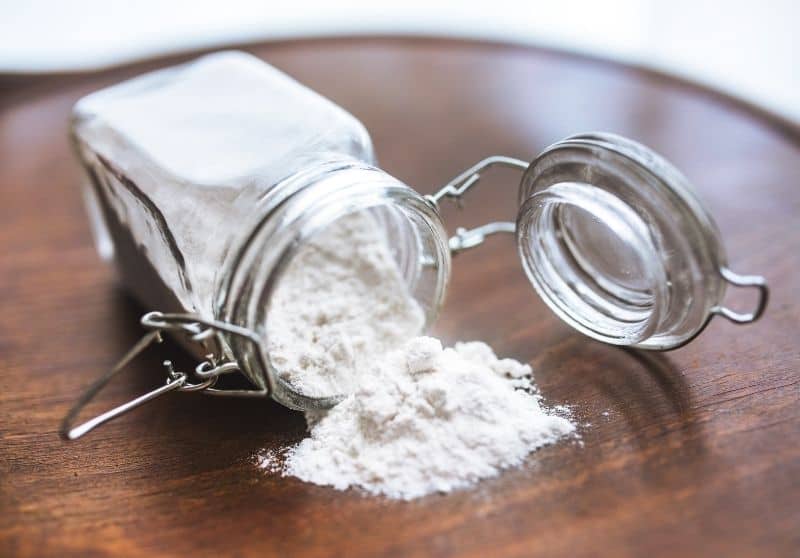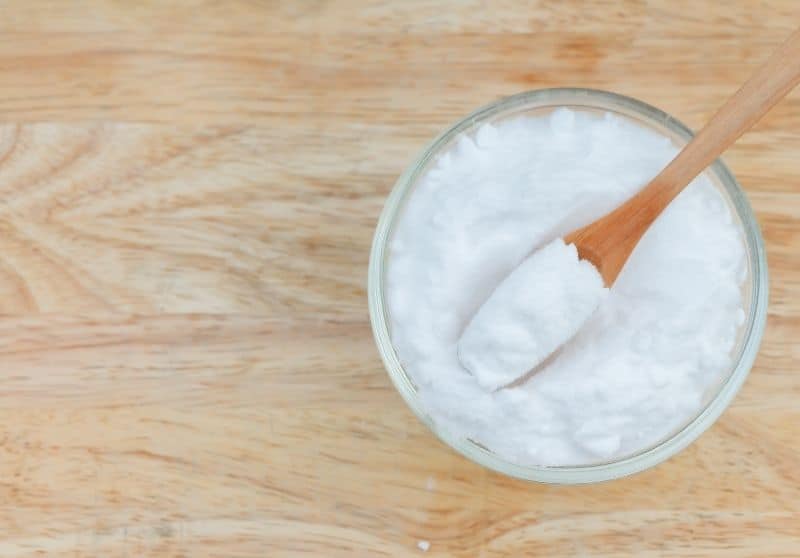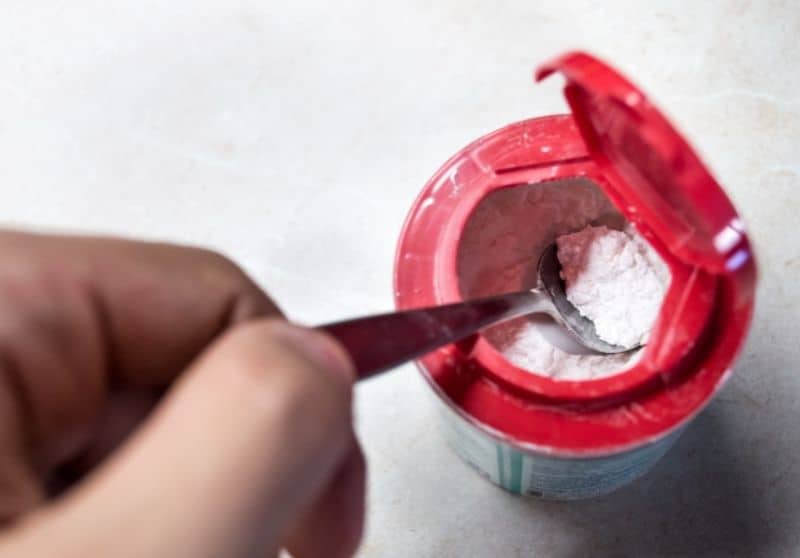Baking soda is a multipurpose home remedy. You can use it to remove stains, odors, and hair dye. If you’re looking to lighten hair color, here’s how to remove hair dye naturally with baking soda.

Baking soda can help gradually remove hair dye and lighten your locks. It’s an abrasive cleaner that scrubs dye molecules from your hair. Baking soda is also alkaline, and the high pH opens the hair cuticle, so it’s easier to strip away the dye molecules.
Is Baking Powder Bad For Hair Dye?
Baking soda works to cleanse hair and restore shine. This can be good for colored hair as it makes it more vibrant.
However, baking soda is generally bad for hair dye when used frequently and excessively.
That’s because baking soda affects the health of your hair, and this can affect the appearance of dyed hair.
Remember, dyed hair has already undergone a damaging chemical process. The downside of baking soda is that it’s an abrasive scrubbing agent that further damages the hair cuticle.
In addition, baking soda has a high pH that opens the cuticle.
With the outer cuticle layer in this state, dyed hair becomes more porous, significantly reducing the vibrancy and color intensity.
You may also notice that the dye is no longer even after applying baking soda to your locks.
Over time, baking soda will leave your strands dry, frizzy, and brittle.
If you want your dye job to last long and look good, this home remedy should be applied in moderation.
Does Baking Powder Remove Hair Dye?

Baking soda is a convenient and cheap remedy for lightening hair naturally.
However, it won’t remove hair dye at the same level as bleach or hydrogen peroxide.
So, it’s best to use it when your hair color is too bright or too dark, and you want to tone it down by a few shades.
The amount of dye you can remove with baking soda depends on the state of your hair and whether the dye is permanent or semi-permanent.
It’s easier to remove dye from porous hair because of the large spaces between cuticles.
It’s also easier to remove semi-permanent dye because most of the dye molecules attach to the outer layer instead of the inner layer of hair fibers.
You’ll have to apply the baking soda several times to get your desired results.
The good news is you can combine baking soda with other home remedies and hair products to speed up the dye removal process.
On its own, baking soda helps strip dye from hair through the following actions:
It’s Alkaline/Has A High pH
Your hair’s optimum pH balance is acidic.
This is the perfect pH level for keeping the cuticle layer closed tight and your hair smooth, shiny, and moisturized.
Conversely, an alkaline pH opens the cuticle. This makes it easier to “shake off” dye molecules clinging to the inside or outside of the hair shaft.
It’s Good For Scrubbing
Baking soda doesn’t dissolve in water.
When mixed with water, it forms a gritty paste that can be used to exfoliate your hair to remove dye molecules, much in the same way you would use it to exfoliate your skin and remove dead skin cells.
When you rub baking soda paste into your hair, the friction will help dislodge some of the dye molecules.
It Reacts With Dye Molecules
When you color your hair, the dye remains in your hair for a long time because it binds to hair fibers.
Shampooing your hair won’t remove the dye as quickly. Baking soda may react with the dye molecules until they bind loosely to hair.
That way, the dye molecules come off easily, and the color fades more quickly.
How To Use Baking Soda To Remove Hair Dye

You can use baking soda on its own to remove hair dye or combine it with other “ingredients” to improve its effectiveness.
Be sure you’re using baking soda and not baking powder, as the two substances are different.
When rinsing your hair during the process, use warm water to open the cuticle and get more dye molecules out.
Follow up with a final rinse using cold water to close the cuticle again.
Without further ado, here are the different ways to remove hair dye with bicarbonate of soda.
Baking Soda Only
- Mix a tablespoon of baking soda with water to create a paste with a medium-thick consistency.
- Rub the paste gently into your hair until it coats every strand.
- Leave the mixture to sit for up to 20 or more minutes.
- Wash your hair with your regular shampoo and rinse thoroughly.
Baking Soda + Hydrogen Peroxide
Be careful about combining baking soda and hydrogen peroxide as the mixture can be particularly harsh on hair. Hydrogen peroxide is already a potent bleaching agent.
- Use a teaspoon to measure and mix equal amounts of baking soda and hydrogen peroxide.
- Massage the paste into your hair.
- Let it sit for 20 minutes or more, depending on how much lighter you want your hair to be.
- Wash your hair with your preferred shampoo and rinse.
Baking Soda + Clarifying or Anti Dandruff Shampoo
Clarifying and anti-dandruff shampoo are sulfate-rich. Sulfates are strong detergents that can strip more color from your hair.
- Combine equal amounts of baking soda and clarifying/anti-dandruff shampoo.
- Massage the paste evenly into your hair.
- Leave to sit before rinsing thoroughly.
Baking Soda + Apple Cider Vinegar
Apple cider vinegar is the perfect complement to baking soda. Its acidity helps to restore your hair and scalp’s pH balance.
With this method, the two substances are not mixed. Otherwise, they will neutralize each other since one is alkaline and the other acidic.
- Combine baking soda with water.
- Work the mixture evenly into your hair.
- Leave for about 20 minutes before washing off.
- Dilute the apple cider vinegar and add a few drops of essential oil to combat the smell.
- Do a final rinse with the apple cider vinegar solution and allow your hair to air dry.
- Do this not more than twice a week to avoid drying your hair.
Read more about how apple cider vinegar can remove hair dye.
Baking Soda + Lemon Juice
This is similar to using baking soda and apple cider vinegar.
Lemon is acidic and will help optimize your hair’s pH balance. It also naturally lightens your hair, especially if you sit out in the sun with lemon in your strands.
- Mix baking soda and water and apply the paste to your hair.
- Rinse your hair, and then apply freshly squeezed lemon juice to your hair.
- Sit out in the sun with the lemon in your hair for a few minutes.
- Wash your hair with shampoo and warm water.
Baking Soda + Dishing Soap
Dawn dishwashing liquid is the best product for this method. It has a strong cleaning formula that cuts through grease and can remove hair dye faster.
- Mix the dish soap and baking soda to form a paste that’s not too thick or watery.
- Apply the paste to your hair until it’s completely covered.
- Leave the mixture for 20 minutes or more before rinsing.
Baking Soda + Epsom Salt
Epsom salt is magnesium sulfate, and there are claims it’s mildly effective at removing hair dye.
- Mix equal amounts of baking soda and Epsom salt.
- Leave to sit for about 20 minutes before shampooing your hair.
Vitamin C + Baking Soda
Vitamin C is ascorbic acid that can weaken the bonds between your hair and color molecules.
- Mix between 5-10 crushed vitamin tablets with two tablespoons of baking soda and add water.
- Apply the paste to your hair thoroughly.
- Let it sit and rinse off with shampoo.
Tips for Using Baking Soda to Remove Hair Dye
Baking soda is one of the most popularly advised methods for removing hair dye. However, if you want your dyed locks to remain healthy, it’s good to keep these tips in mind:
- Use baking soda sparingly if you have super dry hair.
- After applying baking soda, always condition your hair to keep it moisturized, soft, and shiny.
- Baking soda removes hair gradually. The process is long-term, so use a deep conditioner or hair mask regularly to keep your hair healthy since repeated baking soda treatments can be very drying to your hair.
Disclaimer: This site is not intended to provide professional or medical advice. All of the content on LovedByCurls.com is for informational purposes only. All advice should be followed at your own discretion. Ingredients may change at any time so always check the product label before using. Check our full disclaimer policy here.
